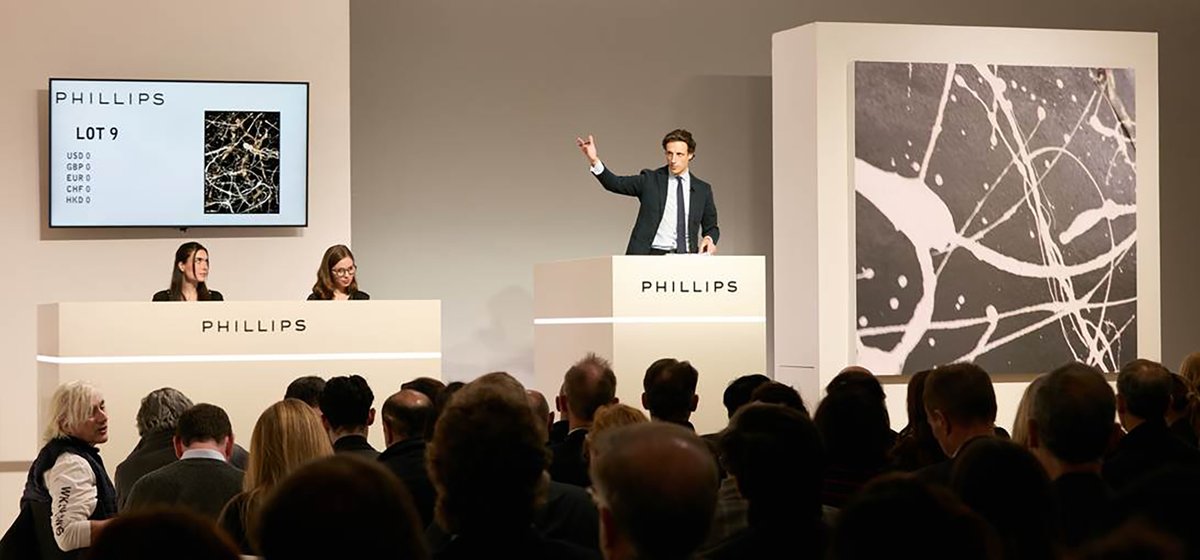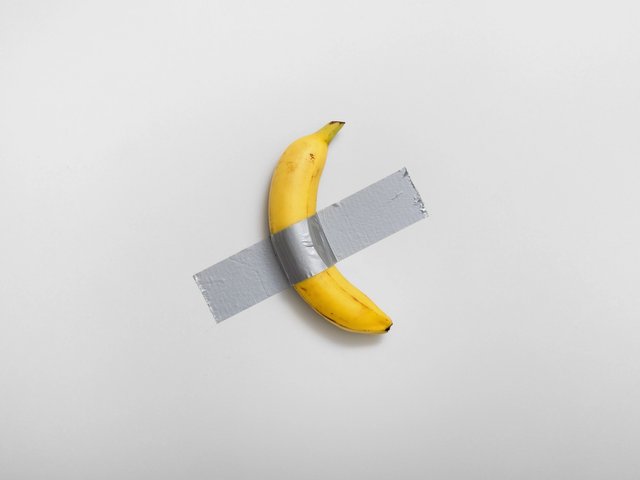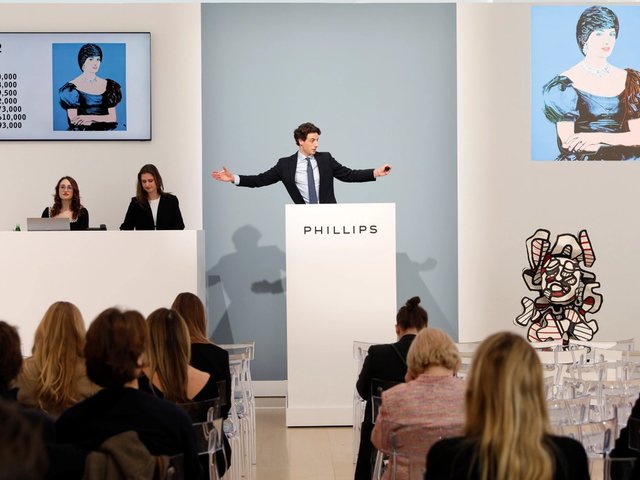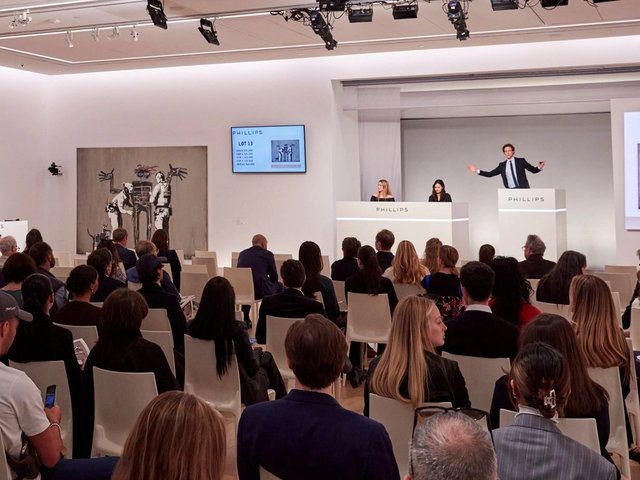Phillips’s evening sale of modern and contemporary art in New York on Tuesday evening (19 November) was a struggle with a half-dozen bright spots, five lots that failed to sell and twice as many that sold for prices below their low estimates. All in all, the sale brought a total hammer price of $44.2m ($54.1m with fees) against a pre-sale estimate of $60.1m to $89m. Of the evening’s 30 lots (three were withdrawn before the sale), 11 were backed by third-party guarantees; the result was good for a sell-through rate of 83.3% by lot and 75% by value.
The result belies the excitement in the room, which filled to capacity before things got underway. Phillips staff had to add two additional rows of seats at the back of the room to accommodate the crowd.

Li Hei Di, Unfolding a flood, 2022 Courtesy Phillips
Perhaps boosted by the crowd’s energy, the sale got off to a romping start, with a work by recent Pace Gallery signee Li Hei Dei surpassing its $60,000 high estimate on the strength of competitive bidding in the room at 432 Park Avenue and with clients on the phones with several specialists. In the end the brilliant, large landscape painting Unfolding a flood (2022) sold for a hammer price of $100,000 ($127,000 with fees) to a bidder on the line with Kevie Yang, Phillips’s deputy chairwoman, Americas and senior international specialist. That result was one of two new artist auction records set during the sale.
The next three lots fared similarly well. A beautiful and untitled Matthew Wong landscape painting from 2017 sold to a bidder in the room for $1.4m ($1.75m with fees), just short of its $1.5m high estimate. A glowing Elizabeth Peyton portrait of the late Nirvana frontman Kurt Cobain from 1995 then sparked a fierce bidding war that pushed it to more than triple its low estimate of $600,000. In the end it hammered for $1.9m ($2.3m with fees), the winning bid logged by a client on the phone with Jean-Paul Engelen, Phillips’s president for the Americas and worldwide co-head of modern and contemporary art. The next lot, Lynette Yiadom-Boakye’s large portrait Watcher (2011) sold to a phone bidder for $1.4m ($1.75 with fees), just shy of its $1.5m high estimate.
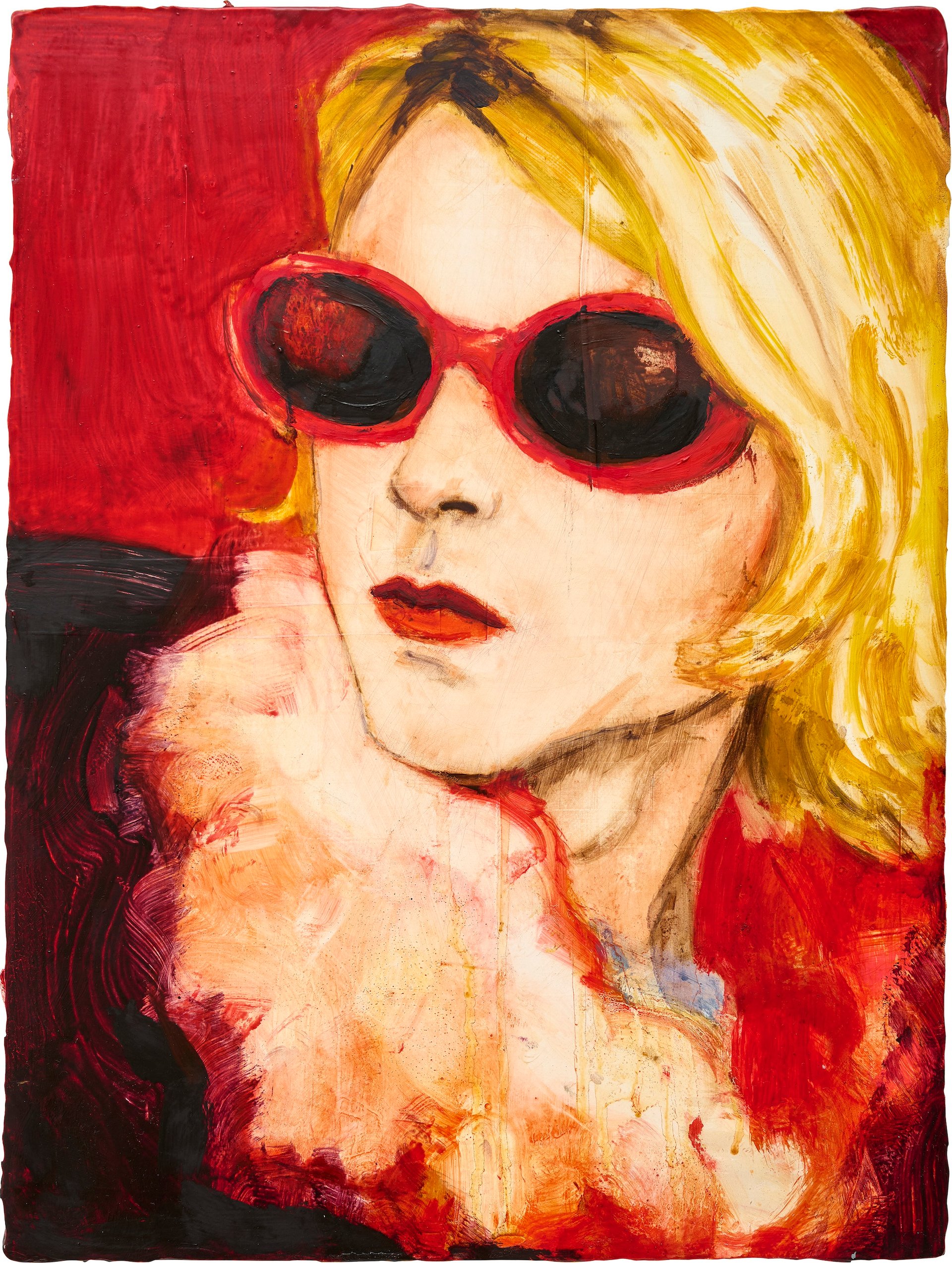
Elizabeth Peyton, Kurt (sunglasses), 1995 Courtesy Phillips
Results for the next several lots were more mixed, with four works in a row selling for prices below, at or very close to their low estimates—but everyone in the packed room was glued to their seats in anticipation of the evening’s star lot. A rare Jackson Pollock drip painting with collaged elements that had previously belonged to the architect and designer Florence Knoll Bassett, Untitled (around 1948) came with an on-request estimate of at least $13m (more than ten times its $1.2m price when it last appeared at auction, at Sotheby’s in 1987). But $13m is exactly what it hammered for ($15.3m with fees) after a short duel between two phone bidders, with the winning bid placed via Miety Heiden, Phillips’s deputy chairwoman and head of private sales. Ultimately, the Pollock accounted for 29.4% of the sale’s total take.
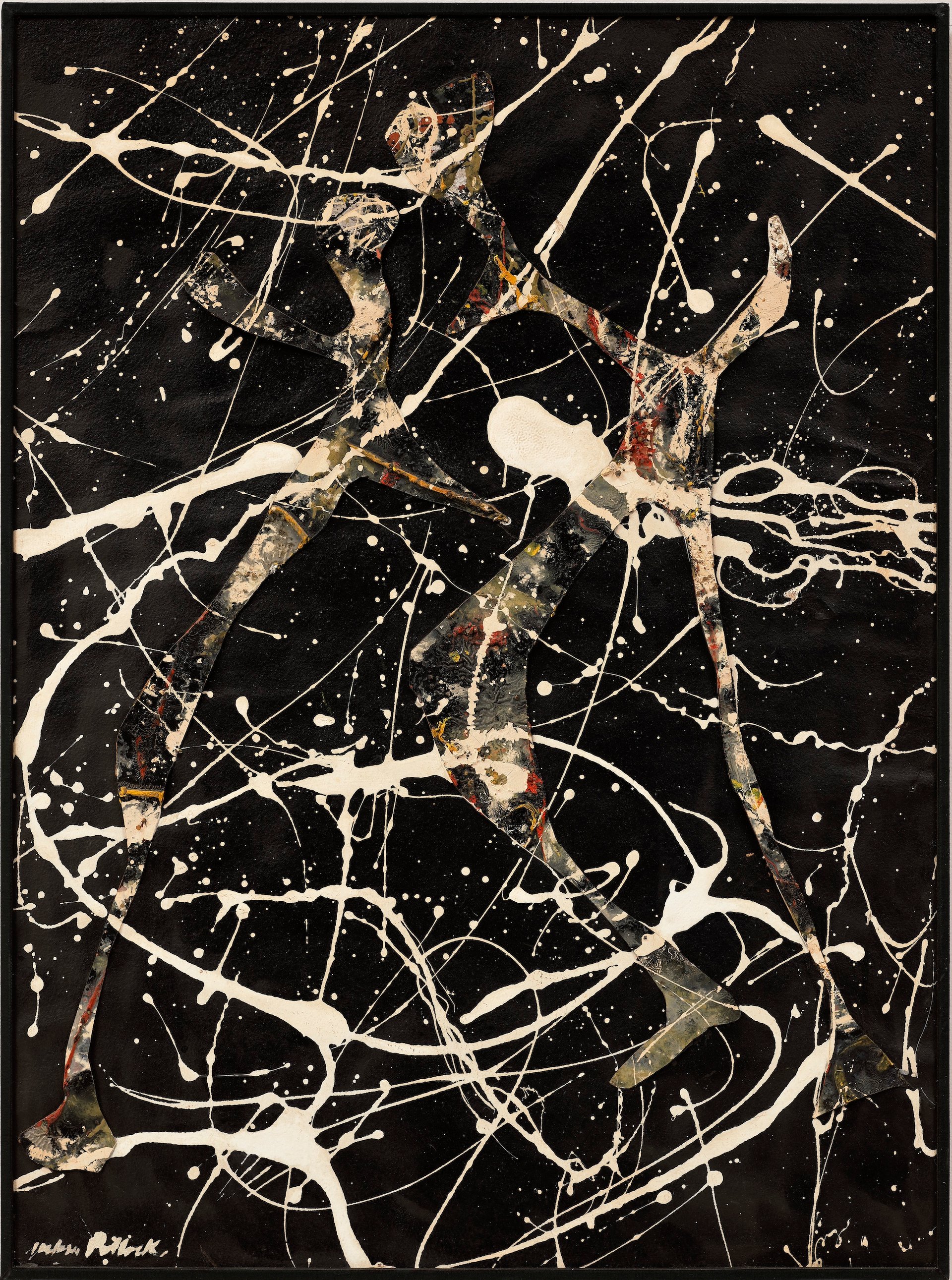
Jackson Pollock, Untitled, around 1948 Courtesy Phillips
From there some of the energy—and quite a bit of the audience—began to leave the room. The night’s first bought-in lot, an Andy Warhol canvas featuring a trio of guns (Gun, from around 1981-82), saw bidding stall at $3.7m, well short of its $4m low estimate. The next lot, a small and untitled Joan Mitchell canvas from around 1960, elicited just one bid and sold below its $900,000 low estimate for a hammer price of $780,000 ($990,600 with fees).
The next lot, a double self-portrait by Jean-Michel Basquiat from 1983 that had previously belonged to actor-turned-artist Johnny Depp, had one of the night’s highest estimates at $10m to $15m. After receiving just one bid, auctioneer Henry Highley appeared to sell it for a hammer price of $9.3m, however following the sale’s conclusion a spokesperson for Phillips revealed that the work had in fact failed to sell—knocking about 17% off the night’s total. (A Basquiat work on paper earlier in the evening sold for its low estimate of $1m, or $1.2m with fees.)
The next four lots—all by blue-chip stars Jeff Koons, Warhol, Pablo Picasso and Alighiero Boetti—sold for hammer prices below their low estimates. The next, a small, textured white-and-gey composition by Robert Ryman with a $1m to $1.5m estimate, was bought in. The rest of the sale was much like this, with a few moments of activity punctuating the sluggishness.
The night’s second-most-expensive lot was a large Cy Twombly canvas from 1960 that previously belonged to Eric Clapton. That rockstar provenance did little to drum up passion for Crimes of Passion I (1960). The painting hammered at its low estimate of $5m, a price that came to $6.1m with Phillips’s fees.
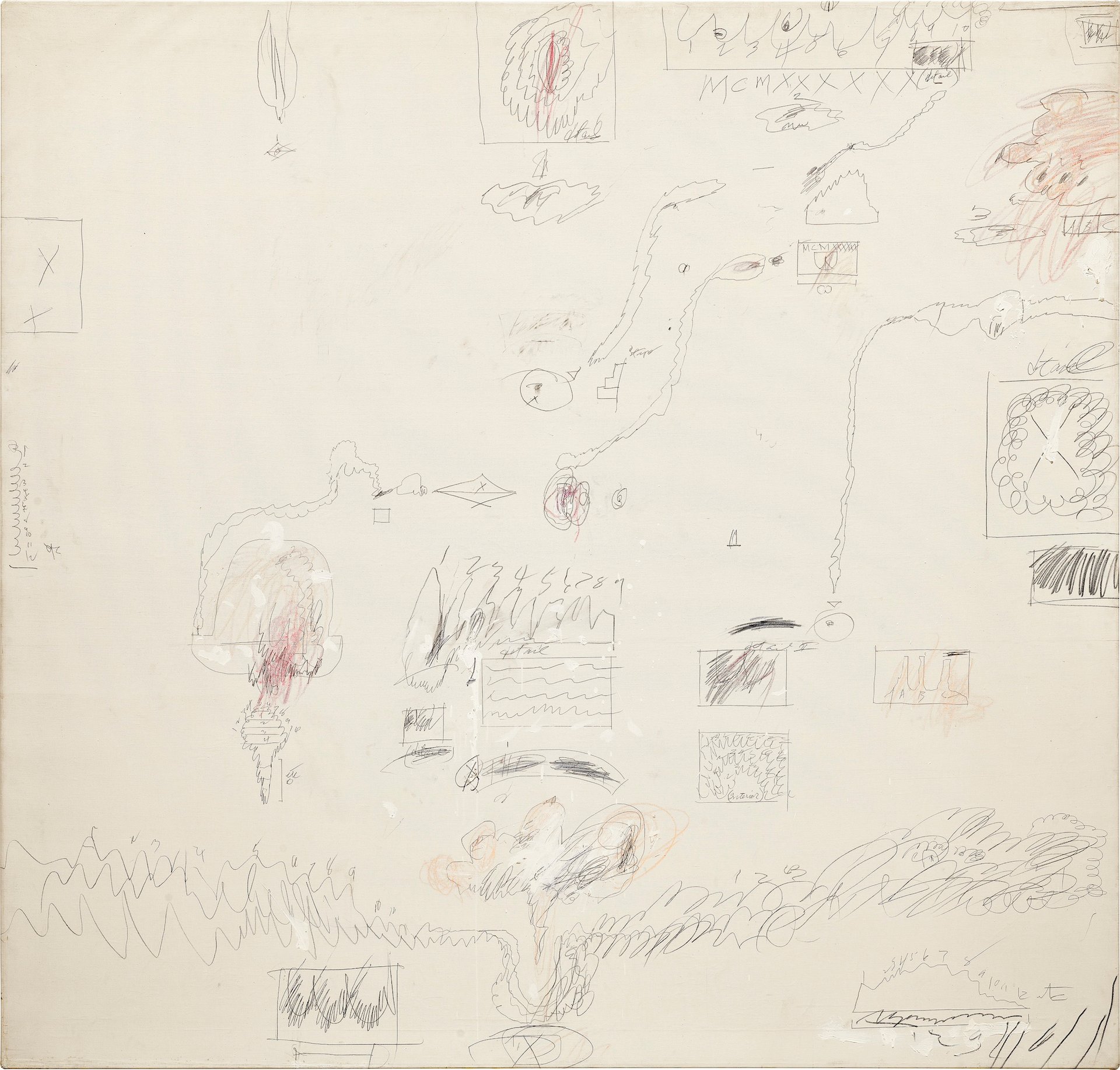
Cy Twombly, Crimes of Passion I, 1960 Courtesy Phillips
The sale’s smallest lot in terms of its dimensions—Alexander Calder’s 7.25in-tall metal sculpture Reclining Bride (1948)—set off probably its biggest bidding contest. An online bidder and three clients on the phone lines competed for the work, which was commissioned as a wedding gift for the late artist and collector Ingeborg ten Haeff by her second husband, Paul Lester Wiener. It eventually sold for $250,000 ($317,500 with fees), more than three times its $70,000 high estimate, to a client on the line with Heiden.
One of the evening’s most recent works, a 12-part mixed media composition depicting a dozen riders on horseback by Derek Fordjour, also sparked a bidding race. Three phone bidders and a woman seated in one of the additional rows at the back of the saleroom charged to a photo finish, with the bidder on the line with Yang prevailing with a winning bid of $900,000—or double the low estimate for Twelve Tribes (2021). With fees, the price came to $1.1m, good for a new secondary market record for Fordjour’s work.
The rest of the sale moved swiftly as the room gradually emptied and those who remained were palpably antsy about grabbing a quick dinner en route to Christie’s for the night’s second round of sales. Still a significant number stuck around for the sale’s last and arguably most timely lot: Andy Warhol’s New York Skyscrapers (1981), a painting that depicts in black, white, gold and diamond dust the signature property of US president-elect Donald Trump.

Andy Warhol, New York Skyscrapers, 1981 Courtesy Phillips
While Warhol wrote in his posthumously-published diary that Trump and his then-wife Ivana were openly disappointed with his painting depicting Trump Tower, two bidders on Tuesday night were enthused enough to push its price past the house’s high estimate of $700,000. It finally sold to a client on the phone with Rebekah Bowling, Phillips’s Los Angeles-based senior specialist and head of 21st century art, for a hammer price of $750,000 ($952,500 with fees). With that, the remaining art market players in the room headed for Christie’s. Many of them would have had to pass the actual Trump Tower, just two blocks away—built on the former site of the Bonwit Teller Department Store, where Warhol had designed window displays in the 1950s and 60s—as they went.
The sale’s total fell well short of Phillips’s expectations for the night and its own results for equivalent sales over the past several seasons, which peaked with a two-part, 56-lot evening a year ago that brought a hammer total of $128.1m—nearly three times higher than Tuesday’s result. The same sale two years ago, which featured 44 lots, brought in a hammer total of $115.7m.
Robert Manley, the house’s deputy chairman and worldwide co-head of modern and contemporary art, had been optimistic before the sale, telling The Art Newspaper: “We’re pretty bullish, pretty confident in the market right now. The stock market is up, other indicators are looking positive.” The result will likely give pause to anyone predicting a quick rebound from the art market correction of the last two years.
New York’s week of sales continued less than an hour after Highley’s final banging of the gavel, with Christie’s 20th century evening sale and auction of works from the collection of Mica Ertegun. Contemporary art evening sales will follow on Wednesday and Thursday nights at Sotheby’s and Christie’s, respectively.


